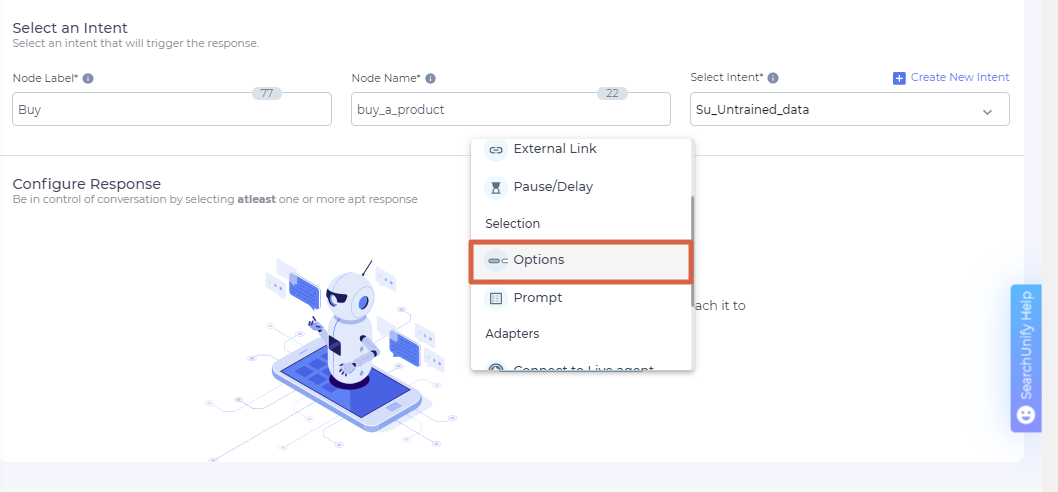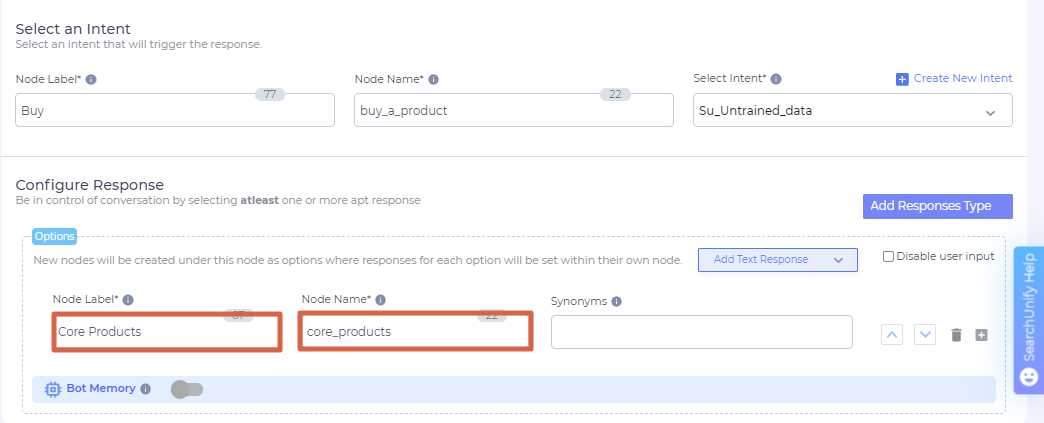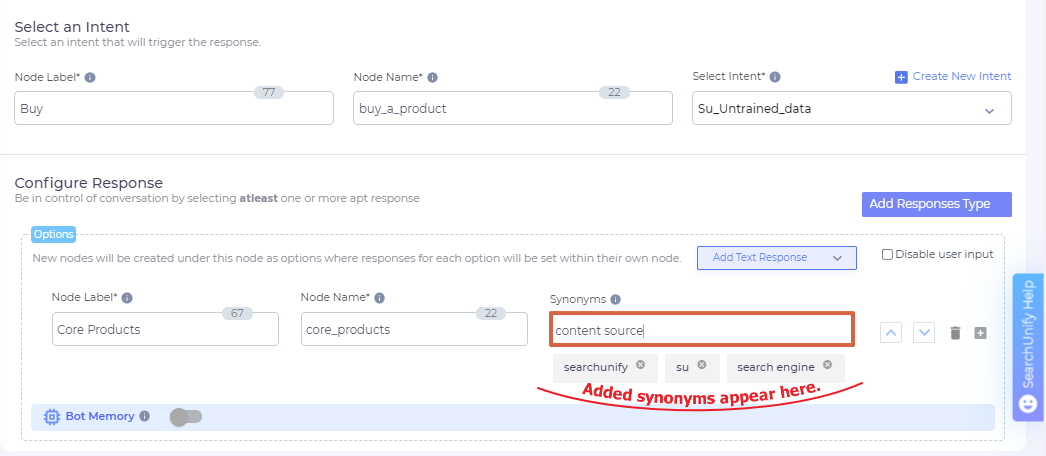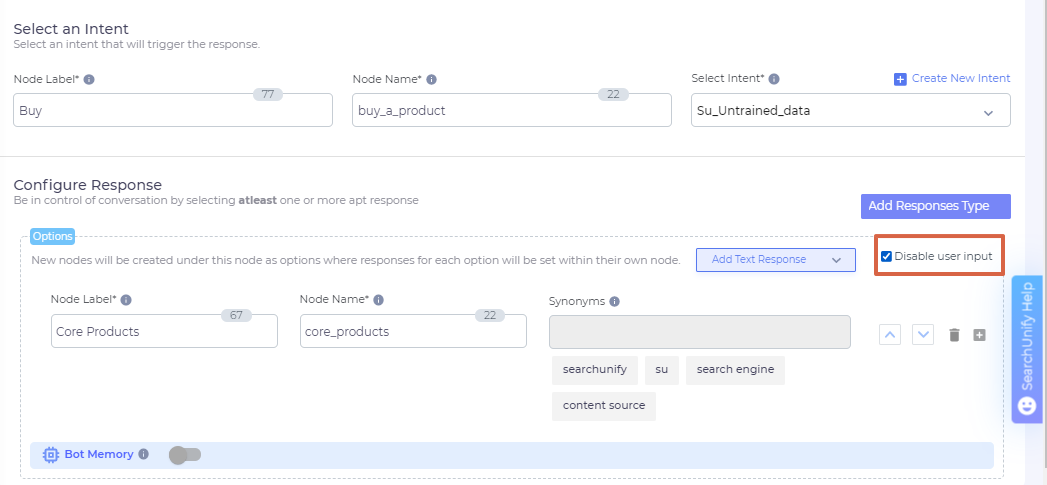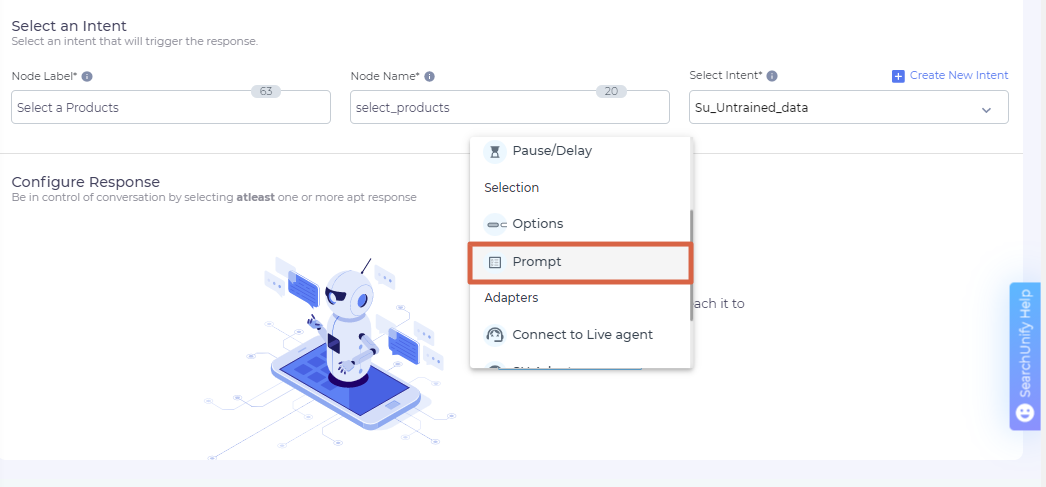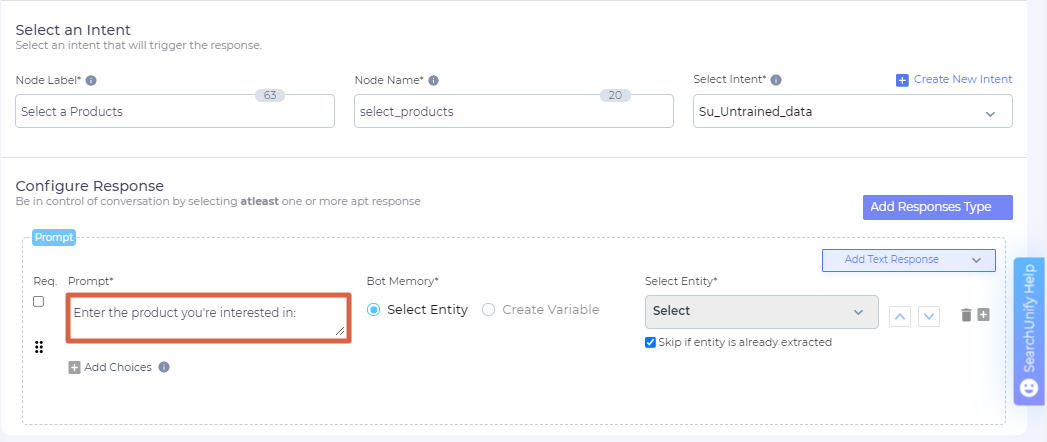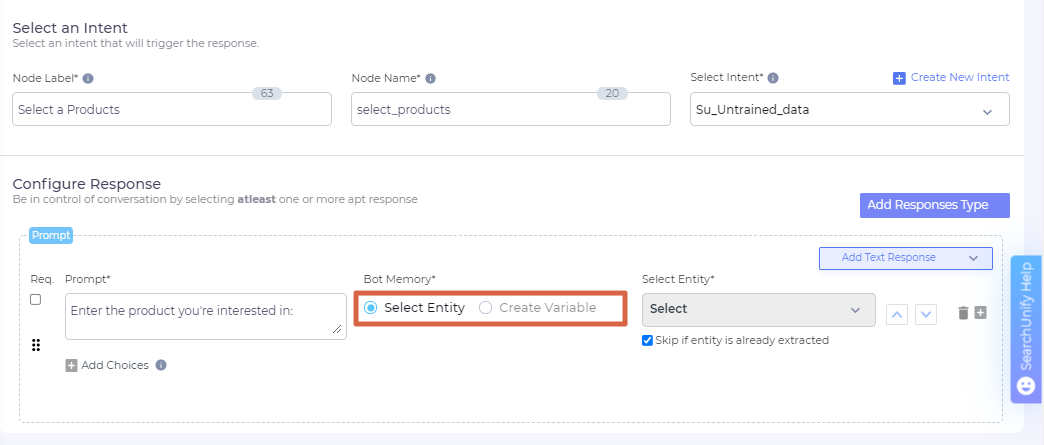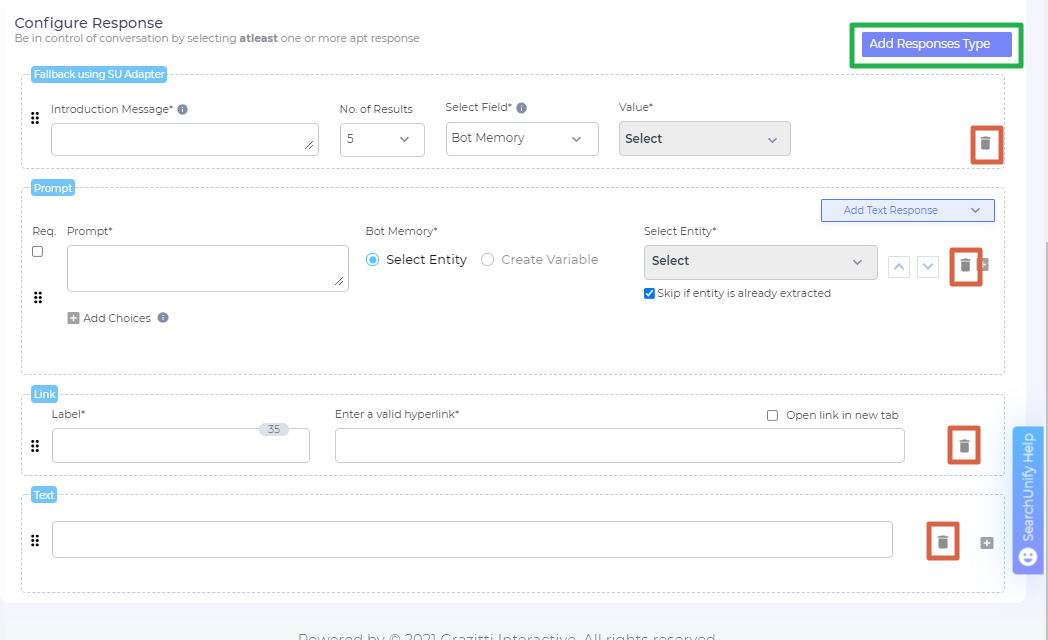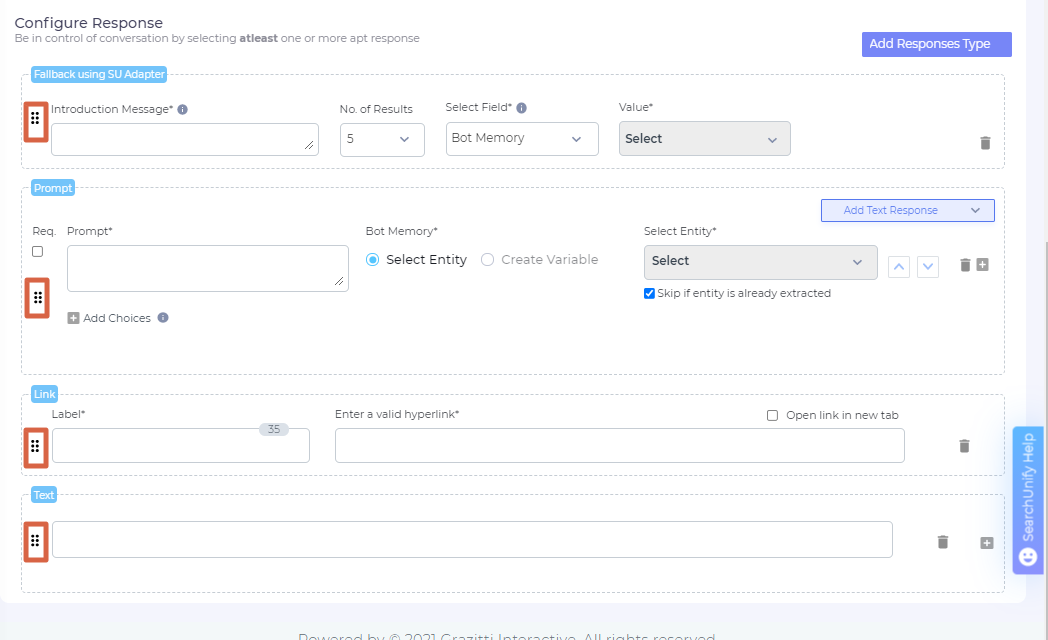Get to Know SUVA Response Types: Selection
Selection offers two response types: Options and Prompt. Options allows an end-user to select one of the predefined input and Prompt allows end-users to compose their own input. Let's review each type.
Options
Options come in handy in guided conversations, where a user can go down one of the few selected tracks. Options are useful when you, let's say, want to know about the customer's interest in a product and there are only three products: A, B, and C. You can create three nodes for A, B, and C respectively and insert them as options in Configure Response.
Unlike other response types, Options can be added only once to a node. Sticking with our example, if A, B, and C are added to node X, then a user clicking any of those products exits node X and moves to the selected node.
-
Click Add Response Type and click Options in Selection.
-
Enter the Node Label and Node Name for the first option. If an end user selects this option, then they will be directed to the node whose Label and Name have been specified.
-
Synonyms offer an alternative to selecting nodes. An Admin can type either the Node Label or its value in Synonyms and still be directed to the specified node. Make sure you add synonyms one at a time and don't use alphanumeric characters in synonyms.
-
You can further connect the node using the Link option. There are three options here; A) Storyboard, B) LLM Response, and C) Continue in story.
-
Selecting Storyboard opens another field—Storyboard—where you can connect the storyboard with a node.
The nodes connected to a storyboard are shown in the image below.
-
Selecting LLM Response opens a new field, Utterance/Query, where you can add an utterance for which an LLM-generated response will be shown.
NOTE. The LLM responses are generated via the FRAG (Federated Retrieval Augmented Generation) approach.
The nodes connected to an LLM Response are shown as in the image below.
-
If you select Continue in story, then the node remains in the same story.
-
-
Check Disable User If user input is disabled, the end-user cannot type and has to select one of the given options. Sticking to our example, the end-user can select A, B, or C but cannot type. It means that synonyms get disabled in this scenario.
-
Use Add Text Response to add a text message to be shown with the options on the chat. Select between Before Options and After Options based on if you want to show the text response before or after the option in the chat.
-
To use the selected option later, you can store it in memory. Toggle on Bot Memory to start. Bot Memory is a method to save user’s input for the option response. This can be saved in an already existing entity or a new variable. When Bot Memory is on, a new form appears where you can choose either to connect the memory with an Entity or create a Variable.
-
Finally, you can check Skip if Entity Already Extracted. On checking, the Bot Memory isn't troubled when entity has already been discovered through previous messages from the end-user. In that case, Options responses are skipped if entity is already extracted from utterance or previous responses.
NOTE
If the system entity date is selected in bot memory then the end users should input (if text input is available) in the valid date format.
NOTE
a) Entities and variables are reset when the current chatbot story ends i.e. they are re-initialised every time a story is triggered.
b) When an entity is already extracted, only a particular option is skipped and not the entire node.
Prompt
While Options guides a conversation by giving an end-user a choice between predefined paths, Prompt brings creativity to the fore. An end-user can type their way to a solution. SUVA automatically detects the entities in the end-user responses and replies accordingly. Bot memory is the same as options. The same entity cannot be used more than once for the prompts and options. If an entity is selected in bot memory then it is extracted from the prompt response. Otherwise the entire response is saved in a variable. You can skip one or all prompts based on the entities extracted previously in the story.
-
To use Prompt as a response, click Add Response and select Prompt.
-
In the Prompt field in Configure Response, write a message for the end-user, who can read the message and reply to it. The reply is going to be stored.
-
Optionally, check Req. if you want to make it mandatory for the end-user to answer. The conversation doesn't proceed until the end-user has answered to the prompt.
-
You can store the end-user reply in Bot Memory either as an Entity or as a Variable.
-
If you check Skip if Entity Already Extracted. On checking, the Bot Memory isn't troubled when entity has already been discovered through previous messages from the end-user.
-
Use Add Text Response to add a text message to be shown with the prompts on the chat. Select between Before Prompts and After Prompts based on if you want to add a text before or after the prompt options pop up in the chat.
NOTE: a) An admin has to add entities correctly and add as many synonyms as possible so that the bot can easily extract them. Values not in the entity are not detected by the bot e.g. location entity has values as Tokyo and London, then the bot does not identify if a user enters the location as Moscow.
b) Verify when Prompt response (using Bot Memory) is followed by SearchUnify adapter (using the bot memory variable of the prompt response) in the same node/story. If the chat user skips the prompt, then fallback should be based on the last user input if the bot memory variable is empty.
Add or Delete a Response on a Node
An admin can insert multiple responses into a node. When business requirements change, the admin can add or delete a response. To add a response to an existing node, click Add a Response and remove an existing response, click ![]() . The function is at the extreme right of each response.
. The function is at the extreme right of each response.
Once you have made the changes, scroll up and Save them.
Change Response Order
A node can house two or more responses. In the default set-up, the latest response ends up on top. But you can change the default order. Use ![]() to drag responses up and down.
to drag responses up and down.
Once you have made the changes, scroll up and Save them.
Last updated: Thursday, September 25, 2025
